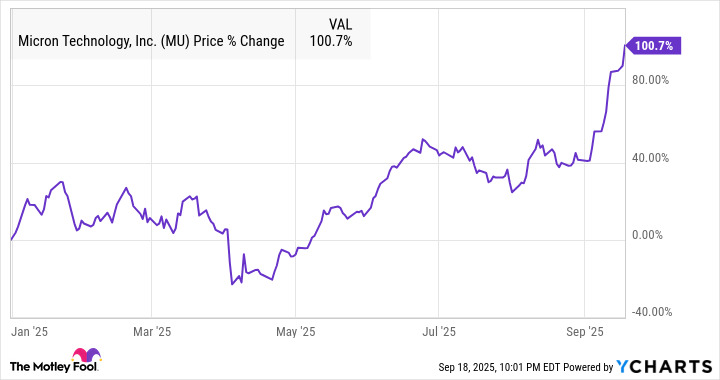Artificial intelligence (AI) stocks keep moving higher, and that's despite worries by some that AI is all hype and no substance. The VanEck Semiconductor ETF, which is flush with AI stocks, is trading up 31% year to date, and there's no shortage of good news for AI investors, some of which suggest that AI has staying power and real financials behind it.
One bit of well-publicized good news in AI is that Oracle just said that it expects its cloud infrastructure business to 14x over the next five years. Elsewhere, Microsoft committed to spending $17 billion with Nebius, the AI cloud infrastructure company, and Nvidia just threw a $5 billion lifeline to industry laggard Intel and announced plans to invest $100 billion in OpenAI. That level of spending suggests AI has staying power.
One AI stock that has not gotten much publicity but is managing plenty of performance is Micron Technologies (MU +3.41%). This domestic integrated device manufacturer specializes in memory chips, and, as the chart below shows, it's been a banner year so far for Micron.
Data by YCharts.
In September alone, Micron's stock price has been on a tear, jumping 43% as the outlook in the memory sector has improved.
What's driving Micron higher?
In an era where the Trump administration has been pushing for more semiconductor production in the U.S., Micron finds itself in an advantageous position because it both designs and manufactures chips in the U.S. Micron was awarded $6.2 billion by the CHIPS Act (approved during the Biden administration), and it's benefited from threats against foreign semiconductor companies. For example, earlier this month, the stock popped as President Donald Trump said he would impose tariffs on semiconductor companies not moving production to the U.S.
The outlook for the memory chip sector has been improving over the last few weeks, along with the broader bullish trend. Micron, like its memory chip peers SK Hynix and Samsung, has been seeing booming demand for high-bandwidth memory (HBM), which is a key component in AI chips. In fact, shares of Micron climbed when SK Hynix rolled out its advanced HBM4 chip, a sign of general enthusiasm for the memory sector.
In its fiscal third quarter, revenue rose 37% to $9.3 billion, driven by a surge in HBM revenue, which was up nearly 50% on a sequential basis. Data center revenue more than doubled on a year-over-year basis, and through the first three quarters of the year, Micron's share of revenue from the data center rose from 30% to 55%.
Reflecting its momentum, Micron raised its fourth-quarter guidance last month, calling for revenue of around $11.2 billion, up from a previous range of around $10.7 billion, and it raised its adjusted earnings per share guidance from a midpoint of $2.50 to a midpoint of $2.85.
Image source: Getty Images.
Why Micron could double again
Unlike most of its AI peers, Micron still trades at a low price-to-earnings ratio. Based on fiscal 2026 estimates, the stock trades at just 12 times earnings, and estimates keep going up. The memory industry is notorious for boom-and-bust cycles, but that could be changing with the arrival and the proliferation of high-bandwidth memory, as the sector now seems tied to the AI boom.
In HBM, demand is still outpacing supply. Micron already sold out all of its HBM inventory for 2025, and demand is still soaring as the market for HBM is expected to grow from $18 billion in 2024 to $35 billion in 2025.
Given the momentum in AI and the gargantuan sums of money flowing into capital expenditures on AI for hardware like HBM, Micron and its memory peers figure to be winners. Though the sector is prone to cyclicality, Micron has a history of making large profits when the industry is healthy, and its margins could still move significantly higher from here, given the excess demand for HBM.
We'll learn more when the company reports fourth-quarter earnings on Tuesday. Keep an eye on its fiscal 2026 guidance. If that tops expectations, the stock could surge again.







